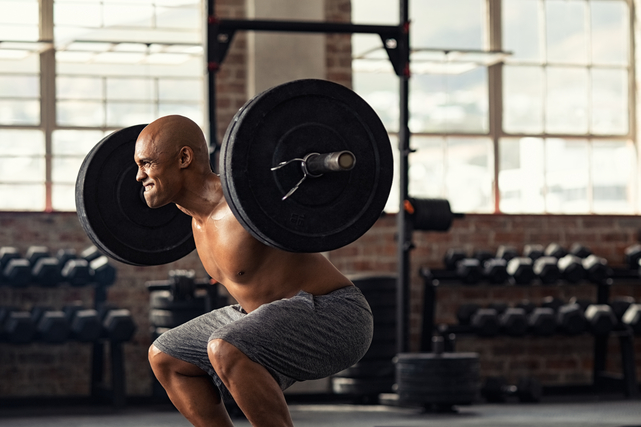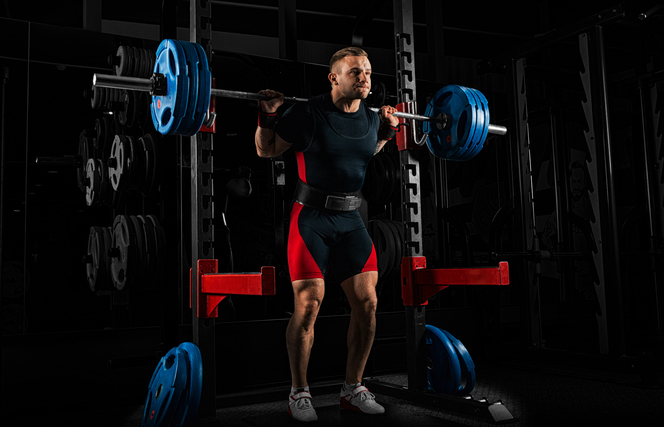Master the Low Bar Back Squat for High-Level Leg Gains | BarBend (original) (raw)
Often touted as the king of exercises, the back squat — more specifically, the low bar back — is a centerpiece in programs running the gamut of goals. Trying to build muscle, strength, mobility, or stability? You’ll probably need to squat.
The skills and attributes you’ll need to acquire in order to safely and effectively load a low bar back squat will produce a huge amount of gains. That’s not to mention the sheer amount of total body strength, muscle, and grit that the low bar back squat gives you. The bar position of this version of the back squat helps most lifters heft more weight than the high bar back squat. That’s why this is the preferred squat version of many powerlifters and other athletes that need to develop max strength — and numbers.

Credit: Rido / Shutterstock
But this lift won’t automatically mean you can slap on more plates and take them for a ride. You’ll need to get this highly technical skill right. Here is how to perform the low bar back squat, as well as everything you need to know about this cornerstone lift.
- **How to Do the Low Bar Back Squat
- Low Bar Back Squat Sets and Reps
- Common Low Bar Back Squat Mistakes
- Low Bar Back Squat Alternatives
- Low Bar Back Squat Variations
- Muscles Worked by the Low Bar Back Squat
- Benefits of the Low Bar Back Squat
- Who Should Do the Low Bar Back Squat
- Frequently Asked Questions
How to Do the Low Bar Back Squat
The low bar back squat is simple in theory. The main goal is to perform the fundamental move of squatting down and standing back up. There are a lot of moving parts that will determine how safely and effectively you can perform this move. Here is a step-by-step breakdown of how to low bar back squat.
Step 1 – The Set-Up

Credit: Andy Gin / Shutterstock
Grab the bar evenly spaced between your hands. Place your hands as closely as you can manage without pain in your shoulders or elbows. Set the bar on the shelf formed with your rear deltoids. With the bar placed on the tight patch of muscle of your upper back, step under the bar. Engage your core with your ribcage stacked over your hips in a powerfully braced position and bear down.
Coach’s Tip: Make sure the bar is resting on your back, not your hands. Keeping your elbows fairly close under the bar can help with this. If needed, try tucking your pinky under the bar instead of curling it over the bar to give your wrist more room to remain neutral.
Step 2 – Unrack and Walk Out

Credit: vhpicstock / Shutterstock
With your brace secured, stand straight up. Lift the bar out of the rack as you do. Take a few precise steps backwards out of the rack. Minimize how much of your brace you relax with efficient movements. Set your foot stance the way you will perform the upcoming set.
Coach’s Tip: Practice your walkout and foot stance under lighter loads so that you can develop the muscle memory you need to move efficiently under a heavy bar.
Step 3 – Squat

Credit: Andy Gin / Shutterstock
Create a 360-degree abdominal brace once again to stabilize your torso under the weight. Generate full-body tension to lock everything in place. Set your hips back into a slight hinge. Bend your knees and squat to at least parallel depth (where the crease of the hips is below the top of your thigh). Once you’ve hit depth, stand back up.
Coach’s Tip: The degree to which your torso is upright will vary based on your limb length, body type, and movement patterns. Aim to keep the bar path straight over your midfoot.
Low Bar Back Squat Sets and Reps
Given the position of the load, the low bar back squat is particularly effective at improving full body strength. As such, programming sets and reps to improve strength or technique to safely execute the exercise are your two main priorities.
- **For Strength: Try a periodized program focusing on one to four working sets of one to six repetitions.
- For Technique: Perform four to five sets of five repetitions utilizing moderate weight and tempo to establish a strong technique.
- For Muscle Mass: Do three to four sets of six to eight repetitions, stopping two reps short of failure with excellent form.
Common Low Bar Back Squat Mistakes
There are a few common mistakes you should avoid when low bar back squatting. Placing the bar too low on your back, trying to stay too upright, flaring your elbows back, and not hinging enough are major recurring errors.
Placing the Bar Too Low
The low bar back squat should be placed lower on your back than a high bar variation (hence the name). However, while some is good, more isn’t always better. Placing the bar any lower than the shelf produced by your rear deltoids might cause some issues with mechanics. Namely, if you go too low, you might not have anywhere to put the bar and will be forced to hold the weight in your hands.
Trying to Stay Too Upright
The low bar back squat does not use the exact same strategy as a high bar back squat. Given the placement of the bar (lower down your back), you will have to engage in more of a hinge in order to recruit as much muscle mass. It will also help you keep the bar balanced over the middle of your foot throughout the entirety of each repetition.
If you stay too upright because you’re thinking of the cue “chest up,” try cueing “traps” to think about pushing up into the bar. That way, you’ll be focusing on your path upward rather than forcing your chest upward.
Elbows Flared Back
A common mistake in the low bar back squat is flaring your elbows back aggressively. This often happens due to not having enough shoulder mobility to assume a more stacked position. Other times, you just don’t have enough muscle mass in the back to support the bar. Be diligent about your shoulder mobility warm-ups and train your upper back to maintain a good platform to rest the bar.
[RELATED: Best Mobility Exercises]
Not Hinging
There is a constant debate about how to initiate the squat descent. Certain lifters are hip-dominant while others are quad-dominant. But that doesn’t mean the two don’t meet. A hip hinge and a squat are two different patterns that meld quite well during the low bar back squat.
As a general rule, hinge back slightly in order to link your posterior chain and assume an extremely strong posture. From there, sit down like a normal squat — bending your knees until you reach the desired depth.
Low Bar Back Squat Alternatives
Not every program, nor every body type, is best served by the low bar back squat. Alternatives that might be better for you or your program are the high bar back squat, front squat, and safety bar squat.
High Bar Squat
A high bar back squat will place the barbell on top of your traps as opposed to your rear deltoids. This variation is widely used by many lifters, including powerlifters.
High bar squats help build your core and back strength with less load and potentially less stress on your lower back. You can transfer this strength nicely into the low bar back squat.
Front Squat
The front squat places the barbell in the opposite position as a high or low bar back squat. As the name suggests, the bar will be in front of you rather than sitting on your back. The bar rests in a nice groove formed by your anterior deltoids — as opposed to your rear delts — and will challenge your ability to remain upright with dramatically less weight.
A strong front squat will fuel the development of a strong back and quads. Since it’s loaded anteriorly, you’ll also get hefty involvement from your core.
Safety Bar Squat
The safety bar squat is a fantastic variation for lifters without large shoulder mobility or who are looking to challenge the squat pattern with a slightly different approach. Gripping the handles and pulling them down slightly will take some of your lat strength out of the exercise, placing greater emphasis on back and core strength.
The safety bar squat serves as a great companion to back squat variations for intermediate or advanced lifters.
Low Bar Back Squat Variations
When you’re trying to get as strong as possible, a few helpful variations can really dial in your technique. Paused squats, tempo squats, and 1 ½ squats are great variations to consider.
Paused Squat
A paused squat will call for you to dead stop in the bottom of your repetition. This reinforces your technique and training your brace like few other exercises can.
Pause briefly (for one to two full seconds) in the hold before driving back up to the starting position. The goal is to retain full body tension. Avoid relaxing or losing position as you stand back up.
Tempo Squat
A tempo squat can help you learn the low bar back squat — and up the ante of the challenge when you get more advanced. Slow each repetition down to force muscular engagement all the way through the range of motion.
Start with a longer tempo (for example, a three-second descent) and work backwards over the course of a few weeks. Aim to retain flawless technique whether you’re slowing down or speeding up the reps.
1 ½ Squat
A 1 ½ squat will force you to complete a full depth squat, stop mid-way up, and then perform another descent before standing completely up. That is one repetition.
The grueling 1 ½ squat can help build positional strength by spending more time in ranges of motion that often develop into sticking points.
Muscles Worked by the Low Bar Back Squat
Your entire body is hammered by heavy back squatting. You can break down the muscles worked into either prime movers (the muscles moving the weight) or stabilizers (the muscles keeping your joints safe). All are important factors in helping you squat heavy.
Quadriceps
One of the major muscle groups performing the heavy lifting will be your quadriceps. Your quads are primarily in charge of flexing your hips and extending your knees. When you stand up, a big part of that will be your quadriceps straightening out your legs.
Glutes
Your quads’ partner in crime will be your glutes. These are responsible for generating huge strength through hip extension. When your hips fire forward back under the bar, that’s your glutes talking.
Adductors
One of the more unsung heroes of the squat are your adductors. The inner thigh muscles are secondary contributors to both pelvic stability and hip extension. They pull double duty by helping you brace and move the weight.
Back
Your back is responsible for supporting the barbell and helping to keep your spine in a neutral position, making this one of the best back exercises. Your traps, lats, and rear deltoids will be the major players here, supporting the bar and buffering force throughout your torso brace.
Core
One of the most important muscle groups during the low bar back squat is your core. Engaging your abdominals (all of them) in a circumferential brace will help keep you from folding over under the bar. This engagement (or lack thereof) will make or break your technique.
Benefits of the Low Bar Back Squat
The low bar back squat is undeniably beneficial for improving full body strength. It also benefits powerlifters by letting you potentially lift more weight than the high bar version.
Full Body Strength
The low bar back squat is one of the most heavily loadable exercises in the gym. Given the amount of muscle groups you’ll be working during this lift, it goes without saying that you should develop some serious full body strength. The low bar back squat is a staple for getting stronger in the gym.
Reduced Range of Motion
Given the placement on your back, the low bar position will reduce your range of motion slightly relative to the high bar squat. This doesn’t mean it will reduce the difficulty, but it definitely will shorten the stroke of each repetition. When you’re going for max loads, this is a huge asset.
High Loadability
Since the low bar back squat recruits the most muscle mass of nearly any exercise, it goes hand-in-hand with being one of the most loadable exercises around. Between maximizing your leverages with a lower bar placement and recruiting nearly every muscle, this is the exercise to perform to throw up some huge numbers.
Who Should Do the Low Bar Back Squat
Depending on the goal and the program, anyone from the average gymgoer to competitive athletes — especially powerlifters — can benefit from the low bar back squat.
Average Gymgoers
The average gymgoer can go their whole training life without ever performing a low bar back squat. However, even those without aspirations of maximal strength can benefit from performing (or being capable of) low bar back squats. The prerequisite shoulder, hip, and spine mobility to successfully low bar back squat is a huge asset moving into any regimen, regardless of your favorite squat type.
Strength Athletes
It makes sense to get strong using arguably the best exercise to get strong.

Credit: Dalibor Despotovic / Shutterstock
Given the loadability, muscle mass recruited, and huge carryover to many different exercises or sports, any type of strength athlete can benefit from performing low bar back squats.
Powerlifters
A powerlifter performs the back squat, bench press, and deadlift on game day. The biggest toal between those three lifts wins the competition. A powerlifter looking to lift the greatest amount of weight within competition will surely benefit from the low bar back squat variation.
Get to Squatting
Although it’s a hard lift, the low bar back squat can also be extremely rewarding. For powerlifters, this move is a no-brainer. But even if you have no intention of stepping onto a competition platform, low bar back squats are one of the biggest bosses for almost every goal. They’re not just for your legs. Instead, they develop your entire body as a unit — just keep (slowly) slapping on those plates.
FAQs
The low bar back squat is one of the most renowned lifts for a reason. It’s understandable if you’ve still got questions. And we have answers.
How should I warm up for low bar back squats?
Use shoulder and hip mobility drills in addition to core stability exercises before you perform low bar back squats. Getting into the best position possible is crucial to see long term results. Stay in top form by making sure your body is mobile enough to low bar back squat. Single-leg Romanian deadlifts and hip airplanes are excellent options for stability.
Are low bar back squats safe?
Low bar back squats come with the same risks of any loaded lift. But they are generally safe when performed with appropriate loads and solid form. Use a properly periodized program to help guide your sets, repetitions, and weights per workout.
How often should I low bar back squat?
For most athletes, low bar back squats should only be performed one to two times per week. Since they are a bit harder to recover from (they recruit a huge amount of muscle mass) and are usually more physically taxing, give yourself ample time between each session.
Featured Image: SOK Studio / Shutterstock